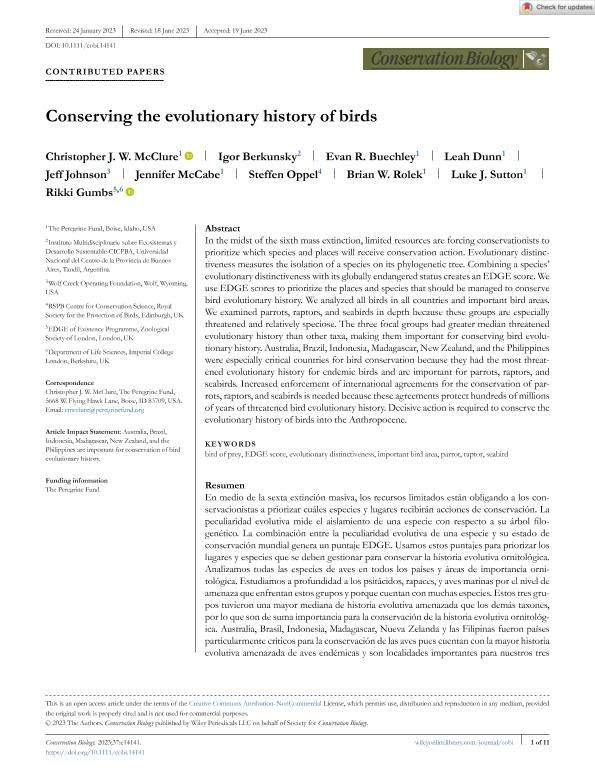Artículo
Conserving the evolutionary history of birds
McClure, Christopher J. W.; Berkunsky, Igor ; Buechley, Evan R.; Dunn, Leah; Johnson, Jeff; McCabe, Jennifer; Oppel, Steffen; Rolek, Brian W.; Sutton, Luke J.; Gumbs, Rikki
; Buechley, Evan R.; Dunn, Leah; Johnson, Jeff; McCabe, Jennifer; Oppel, Steffen; Rolek, Brian W.; Sutton, Luke J.; Gumbs, Rikki
 ; Buechley, Evan R.; Dunn, Leah; Johnson, Jeff; McCabe, Jennifer; Oppel, Steffen; Rolek, Brian W.; Sutton, Luke J.; Gumbs, Rikki
; Buechley, Evan R.; Dunn, Leah; Johnson, Jeff; McCabe, Jennifer; Oppel, Steffen; Rolek, Brian W.; Sutton, Luke J.; Gumbs, Rikki
Fecha de publicación:
12/2023
Editorial:
Wiley Blackwell Publishing, Inc
Revista:
Conservation Biology
ISSN:
0888-8892
Idioma:
Inglés
Tipo de recurso:
Artículo publicado
Clasificación temática:
Resumen
In the midst of the sixth mass extinction, limited resources are forcing conservationists to prioritize which species and places will receive conservation action. Evolutionary distinctiveness measures the isolation of a species on its phylogenetic tree. Combining a species’ evolutionary distinctiveness with its globally endangered status creates an EDGE score. We use EDGE scores to prioritize the places and species that should be managed to conserve bird evolutionary history. We analyzed all birds in all countries and important bird areas. We examined parrots, raptors, and seabirds in depth because these groups are especially threatened and relatively speciose. The three focal groups had greater median threatened evolutionary history than other taxa, making them important for conserving bird evolutionary history. Australia, Brazil, Indonesia, Madagascar, New Zealand, and the Philippines were especially critical countries for bird conservation because they had the most threatened evolutionary history for endemic birds and are important for parrots, raptors, and seabirds. Increased enforcement of international agreements for the conservation of parrots, raptors, and seabirds is needed because these agreements protect hundreds of millions of years of threatened bird evolutionary history. Decisive action is required to conserve the evolutionary history of birds into the Anthropocene.
Archivos asociados
Licencia
Identificadores
Colecciones
Articulos(CCT - TANDIL)
Articulos de CTRO CIENTIFICO TECNOLOGICO CONICET - TANDIL
Articulos de CTRO CIENTIFICO TECNOLOGICO CONICET - TANDIL
Citación
McClure, Christopher J. W.; Berkunsky, Igor; Buechley, Evan R.; Dunn, Leah; Johnson, Jeff; et al.; Conserving the evolutionary history of birds; Wiley Blackwell Publishing, Inc; Conservation Biology; 37; 6; 12-2023; 1-11
Compartir
Altmétricas



